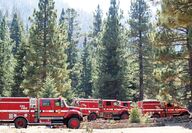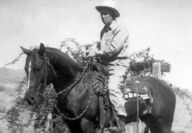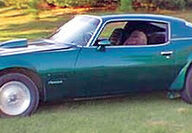Sorted by date Results 226 - 250 of 373

"I wasn't born in Tehachapi, but I chose to live here for years, and that counts for something." – Cactus Jack Cactus Jack was well-known for the beef jerky he used to sell at the corner of Highway 202 and Cummings Valley Road....

"Indian Summer weather in Tehachapi, with warm gentle days and cool nights, can be as sweet as the smile on a sleeping baby." – The Mountain Poet...

"Life is easy; it's music that's hard." – Dave Bouldin Dave Bouldin is retired from the fire service as a station chief but has long been a musician and band leader....

"Time, industry, hard work, patience and a large number of donkeys and mules will overcome all difficulties." – Padre Johann Jakob Baegert Father Baegert was a German Jesuit priest stationed in Baja California in the mid 1700s. Large numbers of mules were used to move the huge sections of pipe needed to build the Los Angeles Aqueduct beginning in 1904. The cement plant at Monolith (now called Lehigh Southwest) was built by the Los Angeles Dept. of Water and Power to supply cement for the a...

The annual Tehachapi Oldtimers Reunion was held on Aug. 1, and more than 425 people gathered in Philip Marx Central Park to visit with friends, acquaintances and in many cases, former neighbors who returned to their old hometown for this celebratory event. The Tehachapi Oldtimers Reunion is a special event that is a testament to Tehachapi's strong sense of community and respect for history and traditions. Most cities and towns don't have an annual celebration like this. They don't even try. The...

As the West in general, and California, of course, experience another devastating wildfire year in 2021, it reminds me of terrible fire that we had 10 years ago. One of the most destructive wildfires that ever swept through the Tehachapi Mountains struck in September of 2011, destroying 32 residences and 30 outbuildings, as well as 19 cars and trucks and 19 RVs as it burned its way through 14,585 acres. Started by a Sept. 4 plane crash that killed both occupants of a small Cessna, the blaze was...

I was born in Cummings Valley on Dec. 21, 1907. We didn't have no doctors here. You had to go to Bakersfield. My mother told me she had a midwife help deliver me, her name was Mrs. Martinez and she lived in Cummings Valley and her husband was a cowboy. That's all there was then, midwives, or the husbands would help deliver the babies. When I got married, my husband worked at Monolith, and before that he worked on ranches. For $30 a month. And we had money then. Now you can work for $30 a day...

When I was 17, in about 1905, I went to work for Nick Williams of Walker Basin, driving a horse and team hauling freight. The route usually went from Caliente up the Lion's Trail to the Walker Basin area, hauling goods for the farmers and miners in the area. I also drove a public stage for Bennett and Wallace, from Caliente to the Piute Post Office at the base of Piute Mountain. Any time a man can drive a team on Piute Mountain, he can drive a harvester. The biggest team I handled was 32-head...

When I was 16, I worked for the Tehachapi News taking photos and writing, and I was the sports editor. I had a 1971 Pontiac Firebird (which I still own) and my friend Dan Wells helped me paint it. Originally it was a lame shade of avocado green like a Sears refrigerator of the era, so my friend Dan Wells helped me repaint it a deep Warrior green. One Friday night I had driven the Firebird down to Bakersfield to cover a Garces football game, and had taken my friend Bill Millhollin, who was the...

The railroad through the Tehachapi Mountains, completed in 1876, is a vital thoroughfare for freight traffic. In fact, the Tehachapi line is considered to be the busiest section of single track mountain railroad in the world. While all the traffic is freight now, for the first nearly 100 years of the railroad's existence, there were daily passenger trains that passed through Tehachapi. It was one of these passenger trains that suffered the worst transportation disaster in Tehachapi history on a...

Last year at about this time Claudia White, the publisher of The Loop newspaper, asked me to write my column about rattlesnakes. Now that warmer weather has come back and reptiles have begun to stir, she thought it would be appropriate to revisit the topic. The Tehachapi Mountains are primarily home to one species of rattlesnake: the Northern Pacific rattlesnake (Crotalus oreganus oreganus). This snake typically has a basic "ground color" that matches their surroundings, and may be light brown,...

We are now in the middle of spring in the Tehachapi Mountains, and despite an extremely dry winter, there are still flowers blooming, birds singing and nesting, reptiles emerging and the other sights and sounds of the gentle season. Although most local areas reported less than four inches of rain this year, some wildflowers, as always, have managed to bloom. California Poppies are opening their bright oranges faces to the sun each morning, closing each evening, and on overcast days or when it...

Spring has now permeated throughout the Tehachapi Mountains, from the lowest elevation foothills at about 500 feet, just above the San Joaquin Valley floor, all the way up to the highest mountains above 7,000 feet. Along with the warmer weather and longer days, spring also signals that the Animal Kingdom has shifted its focus onto reproduction. Spring means baby creatures – mammals, birds, and even amphibians are most likely to produce offspring during the fruitful, fertile months of the v...

Many butterflies can often be found in the Tehachapi Mountains during the warmer months, as blooming wildflowers as well as garden blossoms provide food and refuge for these nectar-feeding adult insects. Among the first to arrive are the Painted Lady (Cynthia cardui) butterflies, which flow northward in a great river of winged beauties in March and April. These butterflies, considered to be the "most cosmopolitan butterfly in the world," start their lives as tiny caterpillars in Mexico and then...

One of the most unique and memorable experiences you can have in California is available just 31 miles from the city of Tehachapi at the Rankin Ranch, a family cattle and guest ranch that was founded in 1863. Nestled in the Tehachapi Mountains in the beautiful and pristine Walker Basin, the Quarter Circle U Rankin Ranch has been raising cattle in Kern County since the days of the Civil War. The sprawling ranch covers 31,000 acres, which is bigger than the five smallest countries in the world – S...

It was 10 years ago that I was able to take a trip that once happened multiple times every day, but now is a very rare experience: a train ride through the Tehachapi Mountains and down to Bakersfield. Of course multiple trains a day still pass through Tehachapi. The rail line through here is considered one of the busiest stretches of single-track mountain railroad in the world, but they're all freight trains. After nearly 100 years of continuous operation, passenger train service was...

The largest non-profit nature preserve on the West Coast is located in Kern County, just a little more than an hour's drive from Tehachapi. This remarkable 95,000-acre place is called the Wind Wolves Preserve, and it serves as a crucial wildlife corridor to help connect two parallel mountain ranges. Wind Wolves Preserve is home to Tule Elk, mountain lions, bears, coyotes, deer, badgers and a host of other animals and birds, including the California Condor, one of the rarest birds in North...

I went to work at the cement plant at Monolith in about 1954. I became a 2nd class welder, and I used to work all around the plant, doing whatever welding needed to be done. One day after I had been there for more than 15 years, they had me working on repairing a bad place in the kiln where the metal was worn – the kiln was like a giant pipe, 18 feet in diameter and 360 feet long. It was made of 1-inch thick steel plate. Over time the bricks lining the inside wore out and had to be replaced, a...

When I was growing up in Mojave in the 1960s, there was lots for kids to do, because we could always go exploring in the desert, and catch lizards and snakes. My Dad was the art teacher at Mojave High. My mother happened to meet a scientist who was in the Mojave area doing research on Western Whiptail lizards, and she mentioned that I loved reptiles, and I ended up getting the chance to assist him. I learned how to catch Whiptails with a noose so he could examine them, because they are...

One of the most widespread bird species living in the Tehachapi Mountains is not native, nor did these birds fly in with their own wings like starlings and house sparrows. No, these familiar fowl arrived in wagons with some of the earliest homesteaders and are pioneers themselves. These early arrivals are known to ornithologists as Gallus gallus domesticus: chickens. The first chickens are believed to have been brought to the Tehachapi area in the late 1850s and early 1860s. The grocery store...

After World War II ended, I separated from the Marine Corp between 1946 and 1948, when I re-enlisted. I spent some of the months in between in Tehachapi, where I met my future wife, Pat Davis, and many young people my own age. One such person was a tall, dark-haired, fun-loving young man named Bobby Lee Smith. He was known for his good nature and tall tales; he could really spin a yarn. One day Bobby Lee told me of a coming rodeo in Kernville and asked if I'd like to go up there and do some...

The two brothers, Coyote and Wolf, went to dance with the bears at Walker Basin. They had a picnic down there and a big dance. Everyone danced, and they danced all night. Coyote's tail was "sparking like a battery" at the top. His brother said, "What's the matter with you?" He was so excited, sparks were coming off his tail. Coyote said nothing and kept dancing. An old lady was gathering wood all night for the fire. She lost her tobacco. She said "pu-zi-ni-kaax." No one could understand her....

Winter is here, and we have some feathered visitors that we don't see much in the warmer months. Let's take a closer look at some of the birds that choose to spend their winters among us. First, here's a couple of simple numbers to help you better comprehend bird life in the Tehachapi Mountains. There are about 250 different North American bird species that have been identified in our area. Some of these are here year-round and are seen daily, others only seasonally, and a handful on the list...

With the arrival of the Winter Solstice on December 21, we're now officially in winter. So what kind of weather does Tehachapi get in January? And how cold can it really get? Well, the coldest temperature on record in the Tehachapi area occurred on the night of December 20, 1990. A brutal cold snap was expected, and it definitely arrived. I was up off and on during the night checking the weather, and I watched as the thermometer outside our kitchen window dropped each time I checked it: 5 degree...

I decided to help get in the Christmas spirit, despite this strange and mournful year, I would make a wreath using only materials gathered locally, mostly from Tehachapi natives with a few heirloom plants incorporated as well. Among the natives that I collected from were California Juniper, White Fir, Creosote Bush, Canyon Oak, Jeffrey Pine, Buckbrush and some Staghorn Lichen found under pine trees after having been dislodged during the recent storm. The heirloom components included rose hips...